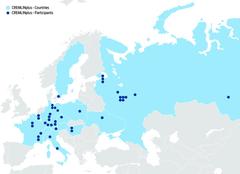URL: https://www.desy.de/news/news_search/index_eng.html
Breadcrumb Navigation
DESY News: EU and Russia strengthen scientific cooperation
News
News from the DESY research centre
EU and Russia strengthen scientific cooperation
Research institutes from the EU and Russia will cooperate even more closely in the future. For this purpose, 35 partners have joined forces in the EU project CREMLINplus, coordinated by DESY, 10 of them from Russia and 25 from the EU and associated countries. At the kick-off meeting at DESY with about 100 representatives of the participating institutions, the Russian Ministry of Research announced in-kind contributions worth 15 million euro for the project. The European Union is funding the four-year project with 25 million euro within the framework of the EU's Horizon 2020 research framework programme.

Participating institutions of CREMLINplus
Within the framework of CREMLINplus (Connecting Russian and European Measures for Large-scale Research Infrastructures - plus), scientific and technical cooperation at Russian large-scale analytical and physical research projects is promoted, including the PIK neutron source in Gatchina near St. Petersburg, the NICA ion collider facility in Dubna and a fourth-generation synchrotron radiation source in Protvino. In addition, a special work package supports cooperation in the development of new detector technologies, such as those used in nuclear physics experiments and neutron sources.
A further priority is the development of an access procedure to Russian large-scale research facilities based on a clearly defined catalogue of criteria in analogy to the European Charter for Access. This should facilitate access to Russian facilities for users from the EU as well. Finally, CREMLINplus provides for a comprehensive training and education programme for managers of large-scale research facilities in Russia and the EU. The aim of the project, which builds on its successful predecessor CREMLIN, is a much higher level of cooperation between European and Russian partners in the field of large-scale research facilities.



